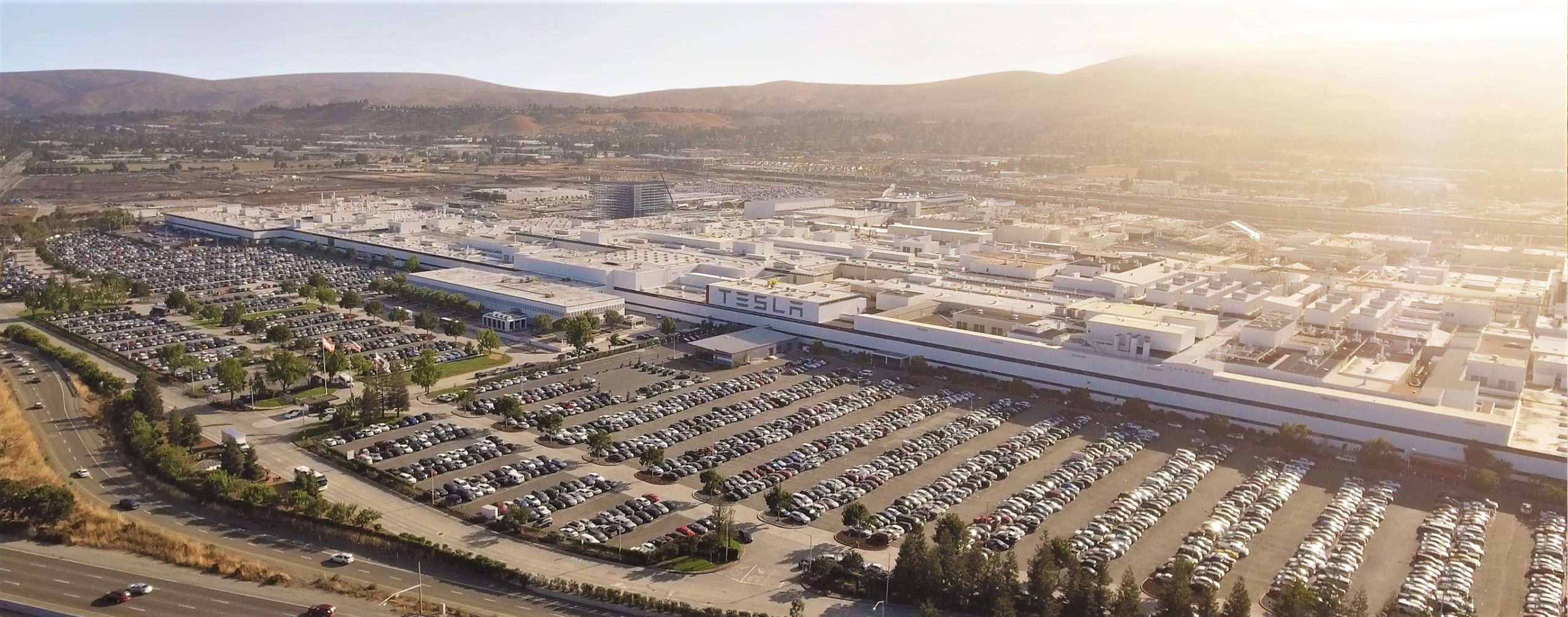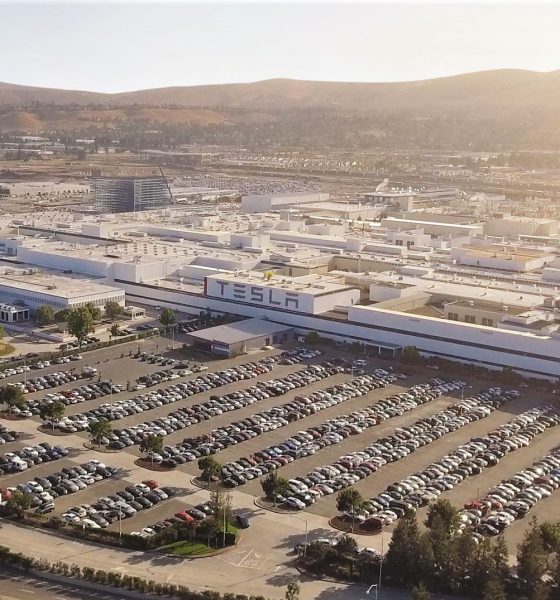

News
Tesla is considering a significant expansion of its Fremont Factory
Tesla’s Fremont Factory could have its production capacity increased, according to CEO Elon Musk. Tesla is “considering expanding [Fremont] significantly,” Musk said in a Tweet last night.
Following Musk’s heavily publicized jab at President Joe Biden on Tuesday night for not mentioning Tesla in the State of the Union Speech with the likes of Ford and GM, who received Biden’s praise for electric vehicle projects resulting in employment opportunities. While Biden commended Ford for $11 billion invested and 11,000 new jobs and GM for $7 billion and 4,000 new employment opportunities in Michigan, Musk hit back with a valid point.
“Tesla has created over 50,000 US jobs building electric vehicles & is investing more than double GM + Ford combined,” he said, alerting “the person running this account” to give Tesla more credit.
While Biden finally gave Tesla its praise last month, more public figures are called for the President to give the automaker credit. Former Kiss bassist and co-lead singer Gene Simmons said, “Actually, @elonmusk makes a solid point to Pres @JoeBiden. The President doesn’t mention Tesla, perhaps because Tesla is non-union and moved to Texas, a “right to work” state. Give Elon Musk/Tesla its due. They are game changers and should be heralded.”
Musk clarified Simmons’ comment, stating that Tesla still operates its Fremont facility in Northern California. Tesla did move its headquarters from Palo Alto to Austin, Texas, late last year. In California, Tesla produces all four of its current vehicles, and the plant has been responsible for handling all demand in North America for several years. The Model S and Model X are also shipped from this plant globally, as Gigafactory Shanghai in China, Tesla’s other active manufacturing plant only produces builds of the Model 3 and Model Y.
Actually, we still operate our California factory, which is the largest auto plant in North America, at full capacity and are considering expanding it significantly.
It has built 2/3 of all electric vehicles in North America, twice as much as all other carmakers combined.
— Elon Musk (@elonmusk) March 3, 2022
Musk said that Tesla is considering an expansion of the Fremont Facility, which has 5.3 million square feet of manufacturing and office space already. However, Fremont is responsible for such a substantial piece of Tesla’s manufacturing footprint, that the automaker may need to expand operations at the plant to keep up with demand. While the Texas factory is set to begin deliveries soon and Gigafactory Berlin is rumored to be receiving final approval tomorrow, production at both factories could begin before the end of the quarter. Gigafactory Shanghai is also expected to have its capacity doubled, adding to Tesla’s considerable additions to its manufacturing output
Tesla says its current production output for Fremont is 600,000 vehicles annually: 500,000 Model 3 and Model Y with 100,000 Model S and Model X.
Nevertheless, Tesla will still need more facilities and more manufacturing space. In Fremont over the past several years, Tesla has expanded production lines and made some temporary manufacturing spaces permanent. Tesla’s Sprung Structure, which contained General Assembly line 4.5, was made permanent last Summer, according to filings found by Teslarati.
“This is the final straw,” or is it?
In May 2020, Musk stated that Tesla will move its Headquarters to Texas and its future programs to Texas and Nevada immediately. Unhappy with the treatment at the time, Tesla was working to reopen the factory when the COVID-19 pandemic was affecting businesses nationwide. Musk stated a potential lawsuit against Alameda County would be filed if Tesla’s Northern California facility was not allowed to reopen. Musk said Tesla would move its operations. “If we even retain Fremont manufacturing activity at all,” Musk said, “it will be dependent on how Tesla is treated in the future. Tesla is the last carmaker left in CA.”
Frankly, this is the final straw. Tesla will now move its HQ and future programs to Texas/Nevada immediately. If we even retain Fremont manufacturing activity at all, it will be dependen on how Tesla is treated in the future. Tesla is the last carmaker left in CA.
— Elon Musk (@elonmusk) May 9, 2020
Several months later, Musk said that Tesla’s headquarters would remain in California “for the short term.” About fifteen months later, Tesla moved its HQ to Austin.
Evidently, Musk plans to keep Fremont in Tesla’s manufacturing plans and may expand the factory altogether. Interestingly, although Fremont has been a ramped factory for several years and produces all four vehicle models, it contributed less to Tesla’s 2021 delivery figures. Gigafactory Shanghai was responsible for 51.7 percent of all deliveries for Tesla last year, outpacing the Fremont factory.
I’d love to hear from you! If you have any comments, concerns, or questions, please email me at joey@teslarati.com. You can also reach me on Twitter @KlenderJoey, or if you have news tips, you can email us at tips@teslarati.com.

Elon Musk
Elon Musk’s X will start using a Tesla-like software update strategy
The initiative seems designed to accelerate updates to the social media platform, while maintaining maximum transparency.

Elon Musk’s social media platform X will adopt a Tesla-esque approach to software updates for its algorithm.
The initiative seems designed to accelerate updates to the social media platform, while maintaining maximum transparency.
X’s updates to its updates
As per Musk in a post on X, the social media company will be making a new algorithm to determine what organic and advertising posts are recommended to users. These updates would then be repeated every four weeks.
“We will make the new 𝕏 algorithm, including all code used to determine what organic and advertising posts are recommended to users, open source in 7 days. This will be repeated every 4 weeks, with comprehensive developer notes, to help you understand what changed,” Musk wrote in his post.
The initiative somewhat mirrors Tesla’s over-the-air update model, where vehicle software is regularly refined and pushed to users with detailed release notes. This should allow users to better understand the details of X’s every update and foster a healthy feedback loop for the social media platform.
xAI and X
X, formerly Twitter, has been acquired by Elon Musk’s artificial intelligence startup, xAI last year. Since then, xAI has seen a rapid rise in valuation. Following the company’s the company’s upsized $20 billion Series E funding round, estimates now suggest that xAI is worth tens about $230 to $235 billion. That’s several times larger than Tesla when Elon Musk received his controversial 2018 CEO Performance Award.
As per xAI, the Series E funding round attracted a diverse group of investors, including Valor Equity Partners, Stepstone Group, Fidelity Management & Research Company, Qatar Investment Authority, MGX, and Baron Capital Group, among others. Strategic partners NVIDIA and Cisco Investments also continued support for building the world’s largest GPU clusters.
News
Tesla FSD Supervised wins MotorTrend’s Best Driver Assistance Award
The decision marks a notable reversal for the publication from prior years, with judges citing major real-world improvements that pushed Tesla’s latest FSD software ahead of every competing ADAS system.

Tesla’s Full Self-Driving (Supervised) system has been named the best driver-assistance technology on the market, earning top honors at the 2026 MotorTrend Best Tech Awards.
The decision marks a notable reversal for the publication from prior years, with judges citing major real-world improvements that pushed Tesla’s latest FSD software ahead of every competing ADAS system. And it wasn’t even close.
MotorTrend reverses course
MotorTrend awarded Tesla FSD (Supervised) its 2026 Best Tech Driver Assistance title after extensive testing of the latest v14 software. The publication acknowledged that it had previously criticized earlier versions of FSD for erratic behavior and near-miss incidents, ultimately favoring rivals such as GM’s Super Cruise in earlier evaluations.
According to MotorTrend, the newest iteration of FSD resolved many of those shortcomings. Testers said v14 showed far smoother behavior in complex urban scenarios, including unprotected left turns, traffic circles, emergency vehicles, and dense city streets. While the system still requires constant driver supervision, judges concluded that no other advanced driver-assistance system currently matches its breadth of capability.
Unlike rival systems that rely on combinations of cameras, radar, lidar, and mapped highways, Tesla’s FSD operates using a camera-only approach and is capable of driving on city streets, rural roads, and freeways. MotorTrend stated that pure utility, the ability to handle nearly all road types, ultimately separated FSD from competitors like Ford BlueCruise, GM Super Cruise, and BMW’s Highway Assistant.
High cost and high capability
MotorTrend also addressed FSD’s pricing, which remains significantly higher than rival systems. Tesla currently charges $8,000 for a one-time purchase or $99 per month for a subscription, compared with far lower upfront and subscription costs from other automakers. The publication noted that the premium is justified given FSD’s unmatched scope and continuous software evolution.
Safety remained a central focus of the evaluation. While testers reported collision-free operation over thousands of miles, they noted ongoing concerns around FSD’s configurable driving modes, including options that allow aggressive driving and speeds beyond posted limits. MotorTrend emphasized that, like all Level 2 systems, FSD still depends on a fully attentive human driver at all times.
Despite those caveats, the publication concluded that Tesla’s rapid software progress fundamentally reshaped the competitive landscape. For drivers seeking the most capable hands-on driver-assistance system available today, MotorTrend concluded Tesla FSD (Supervised) now stands alone at the top.
News
Elon Musk’s Grokipedia surges to 5.6M articles, almost 79% of English Wikipedia
The explosive growth marks a major milestone for the AI-powered online encyclopedia, which was launched by Elon Musk’s xAI just months ago.

Elon Musk’s Grokipedia has grown to an impressive 5,615,201 articles as of today, closing in on 79% of the English Wikipedia’s current total of 7,119,376 articles.
The explosive growth marks a major milestone for the AI-powered online encyclopedia, which was launched by Elon Musk’s xAI just months ago. Needless to say, it would only be a matter of time before Grokipedia exceeds English Wikipedia in sheer volume.
Grokipedia’s rapid growth
xAI’s vision for Grokipedia emphasizes neutrality, while Grok’s reasoning capabilities allow for fast drafting and fact-checking. When Elon Musk announced the initiative in late September 2025, he noted that Grokipedia would be an improvement to Wikipedia because it would be designed to avoid bias.
At the time, Musk noted that Grokipedia “is a necessary step towards the xAI goal of understanding the Universe.”
Grokipedia was launched in late October, and while xAI was careful to list it only as Version 0.1 at the time, the online encyclopedia immediately earned praise. Wikipedia co-founder Larry Sanger highlighted the project’s innovative approach, noting how it leverages AI to fill knowledge gaps and enable rapid updates. Netizens also observed how Grokipedia tends to present articles in a more objective manner compared to Wikipedia, which is edited by humans.
Elon Musk’s ambitious plans
With 5,615,201 total articles, Grokipedia has now grown to almost 79% of English Wikipedia’s article base. This is incredibly quick, though Grokipedia remains text-only for now. xAI, for its part, has now updated the online encyclopedia’s iteration to v0.2.
Elon Musk has shared bold ideas for Grokipedia, including sending a record of the entire knowledge base to space as part of xAI’s mission to preserve and expand human understanding. At some point, Musk stated that Grokipedia will be renamed to Encyclopedia Galactica, and it will be sent to the cosmos.
“When Grokipedia is good enough (long way to go), we will change the name to Encyclopedia Galactica. It will be an open source distillation of all knowledge, including audio, images and video. Join xAI to help build the sci-fi version of the Library of Alexandria!” Musk wrote, adding in a later post that “Copies will be etched in stone and sent to the Moon, Mars and beyond. This time, it will not be lost.”








